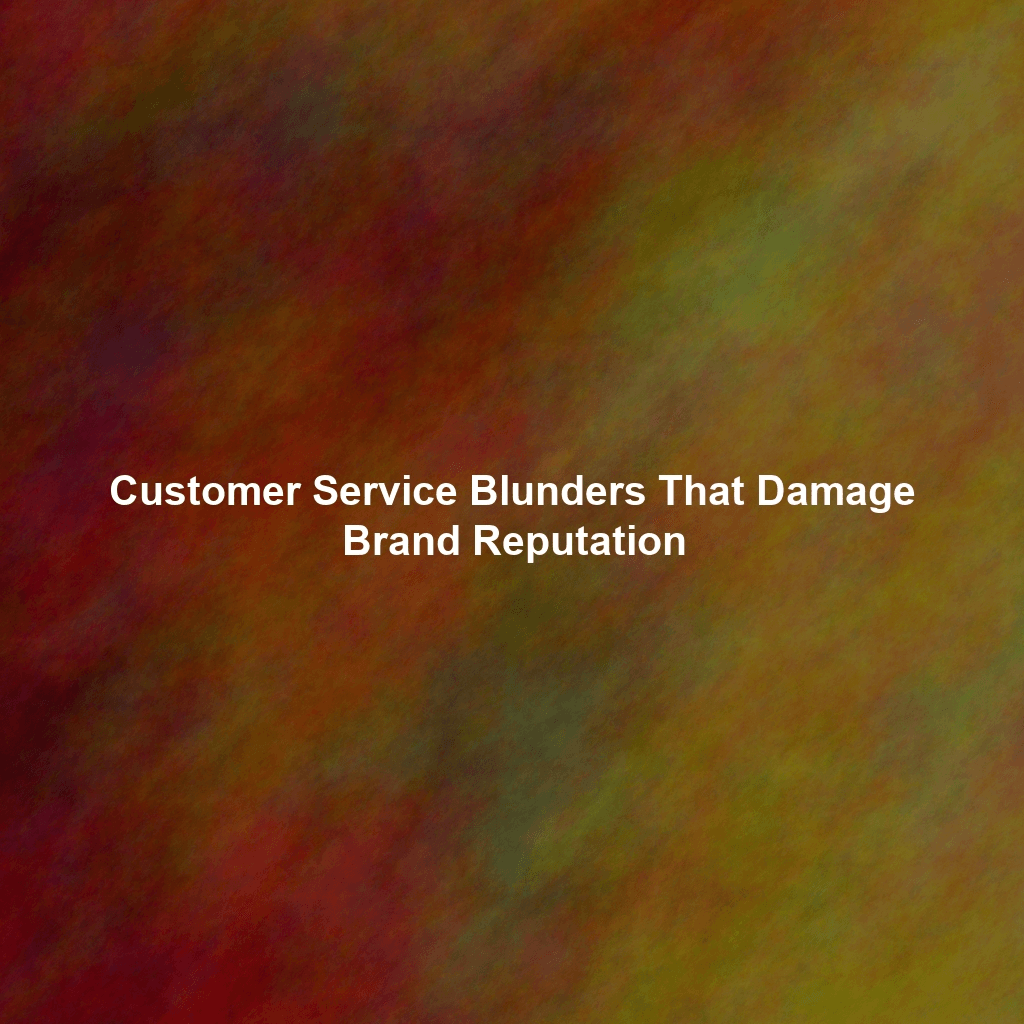The Digital Amplification of Blunders: Why Every Interaction Matters More Now
The rise of social media, review sites, and instant messaging has fundamentally altered the stakes of customer service. A single negative experience, once confined to a phone call or a private email, can now be amplified globally within minutes. This digital amplification means:
- Instant Visibility: A customer’s complaint or frustration can go viral before your team even has a chance to respond.
- Permanent Records: Negative reviews and social media posts often remain online indefinitely, impacting future customer perceptions long after the initial incident.
- Loss of Control Over Narrative: The customer, or the online community, can dictate the narrative if your brand is slow or ineffective in its response.
- Erosion of Trust: Public blunders erode trust not just with the affected customer, but with potential customers observing the interaction.
This reality necessitates a proactive, agile, and customer-centric approach to every single interaction.
Seven Critical Customer Service Blunders That Capsize Brands
1. Ignoring Customer Complaints: The Silent Killer of Loyalty
One of the most critical and strategically damaging mistakes a company can make is ignoring customer complaints. In the age of instant feedback and high customer expectations, silence is not golden; it’s perceived as blatant indifference, disrespect, and a profound lack of accountability. Customers expect their concerns to be acknowledged, addressed, and resolved promptly and transparently. When a complaint goes unanswered, it sends an unmistakable message that the company neither values its customers’ time nor their business.
This indifference can lead to several devastating, quantifiable outcomes:
- Escalation & Public Shaming: Unresolved issues often escalate from private complaints to public accusations on social media, review sites, or even consumer protection agencies, resulting in significant reputational damage.
- Negative Word-of-Mouth (WOM) & Reduced Referrals: Dissatisfied customers are statistically far more likely to share their negative experiences with friends, family, and online communities than positive ones. This erodes your referral pipeline and increases customer acquisition costs.
- Direct Business Loss & Churn: Customers who feel ignored are highly unlikely to return for future business and will actively seek out competitors who demonstrate superior service and responsiveness. This directly impacts your customer lifetime value (CLTV).
To avoid this egregious blunder, implement a robust, multi-channel system for tracking, acknowledging, and responding to customer complaints with speed and empathy. This system should include:
- Omni-Channel Accessibility: Offer various, easily accessible channels for customers to submit complaints (e.g., dedicated email, direct phone line, live chat, social media direct messages, web forms).
- Prompt Acknowledgment: Acknowledge receipt of complaints within a defined, reasonable timeframe, ideally within 24 hours, even if it’s just to confirm receipt and provide an estimated resolution time.
- Thorough Investigation & Root Cause Analysis: Investigate each complaint meticulously to understand the underlying root cause of the issue, not just the symptom. This prevents recurrence.
- Effective & Documented Resolution: Provide a satisfactory resolution that directly addresses the customer’s concerns and demonstrates a genuine commitment to customer satisfaction. Document all steps for future reference and trend analysis.
2. Lack of Empathy: The Emotional Disconnect & Devaluation
Customers aren’t just seeking solutions; they are seeking understanding and validation of their experience. A customer service interaction devoid of genuine empathy can leave a customer feeling devalued, frustrated, and unheard, even if the underlying issue is eventually resolved. While efficiency is crucial, it should never come at the expense of human connection. Agents who sound robotic, dismissive, or uninterested can inadvertently create a profoundly negative experience, driving customers away regardless of the technical resolution.
Empathy involves actively listening, understanding, and acknowledging the customer’s emotions. It means putting yourself in their shoes and recognizing their frustration, disappointment, or anger. Demonstrating empathy can effectively defuse tense situations, build immediate rapport, and even turn a negative interaction into a positive brand touchpoint, even when a perfect resolution isn’t immediately possible.
To foster genuine empathy in your customer service team, consider the following strategic initiatives:
- Comprehensive Empathy Training: Provide rigorous training on active listening, emotional intelligence, de-escalation techniques, and conflict resolution. Role-playing exercises simulating real-world customer service scenarios can be highly effective.
- Empathetic Language Guidelines: Develop and reinforce guidelines for using empathetic language (e.g., “I understand how frustrating that must be,” “I apologize for the inconvenience you’ve experienced”).
- Positive Reinforcement & Recognition: Recognize and reward agents who consistently demonstrate exceptional empathy in their interactions, making it a core performance metric.
- Human-Centric Metrics: Balance efficiency metrics (e.g., average handling time) with quality metrics that assess empathy and resolution effectiveness (e.g., Customer Satisfaction Score, First Contact Resolution).
3. Making False Promises: The Irreparable Trust Breaker
Overpromising and consistently underdelivering is a surefire way to fundamentally damage your brand’s reputation and erode customer trust. Whether it’s promising unrealistic delivery times, guaranteeing specific results that are beyond your control, making vague claims about product performance, or offering discounts that don’t materialize, false promises create immediate disappointment and long-term skepticism.
Customers value honesty and transparency, even if it means admitting limitations or imperfections. It is always strategically superior to underpromise and consistently overdeliver than to set unrealistic expectations and inevitably fall short. This builds credibility and fosters long-term relationships.
To avoid making false promises, ensure that your marketing materials, sales pitches, and customer service interactions are accurate, realistic, and internally consistent. This includes:
- Realistic Timelines: Provide accurate delivery times, service activation windows, and project completion estimates. Avoid making guarantees that you cannot reliably keep.
- Clear & Accurate Product/Service Descriptions: Ensure that your product descriptions, feature lists, and service level agreements (SLAs) are clear, concise, and precisely accurate. Avoid hyperbole or ambiguous language.
- Honest Representation of Capabilities: Avoid exaggerating the benefits or capabilities of your products or services. Focus on verifiable value.
- Transparent Communication of Delays/Issues: Proactively communicate openly and honestly with customers about any potential delays, issues, or changes that may arise, explaining the situation and outlining corrective actions.
- Internal Alignment: Ensure that marketing, sales, and customer service teams are fully aligned on what can and cannot be promised, and that all customer-facing staff are trained on these boundaries.
4. Being Unresponsive on Social Media: The Public Relations Catastrophe
Social media has evolved into a critical, highly visible channel for customer service and brand perception. Customers frequently turn to platforms like X (formerly Twitter), Facebook, Instagram, and review sites to voice their concerns, ask questions, and share their experiences (both positive and negative). Ignoring these inquiries or complaints on public channels can quickly escalate into a public relations nightmare, damaging your brand’s image in plain sight.
When customers post negative comments or complaints on social media, it’s essential to respond promptly, professionally, and publicly (where appropriate). A public response demonstrates that you’re actively listening, that you care about their concerns, and that you are accountable. However, it’s equally important to avoid getting into public arguments, engaging in combative behavior, or making promises you can’t keep in a public forum. The goal is to acknowledge, empathize, and then move the conversation to a private channel for resolution.
To effectively manage customer service on social media, consider the following strategic imperatives:
- Proactive Social Listening: Actively monitor all relevant social media channels for mentions of your brand, direct messages, comments, and reviews, using dedicated social listening tools.
- Rapid Response Protocol: Establish clear internal protocols for rapid response times (ideally within a few hours, or even minutes for critical issues). Assign dedicated personnel for social customer service.
- Professional & Empathetic Tone: Maintain a consistently professional, empathetic, and helpful tone in all public responses. Avoid defensiveness or sarcasm.
- Strategic “Take it Offline”: If the issue is complex, sensitive, or requires personal information, offer to take the conversation offline to a more private channel (e.g., direct message, email, phone call) to ensure privacy and facilitate a more detailed resolution.
- Leverage Feedback for Improvement: Systematically collect and analyze social media feedback to identify recurring issues, emerging trends, and areas for improvement in your products, services, and overall customer experience.
5. Failing to Empower Your Employees: The Bureaucratic Maze & Customer Frustration
When customer service representatives (CSRs) lack the authority, training, or resources to resolve issues independently, customers are often forced to navigate a frustrating bureaucratic maze of transfers, escalations, and repeated explanations. This leads to significant frustration, wasted time, and ultimately, dissatisfaction. Empowering your frontline employees to make decisions that benefit the customer can dramatically improve the customer experience, increase first-contact resolution rates, and boost employee morale.
Empowerment doesn’t mean giving employees free rein to do whatever they want. It means providing them with the clear guidelines, comprehensive training, necessary resources (e.g., access to customer history, relevant policies), and the defined authority they need to resolve issues efficiently and effectively at the first point of contact. This reduces friction and signals trust to the customer.
To strategically empower your customer service team, consider:
- Defined Decision-Making Authority: Clearly define the scope of decisions agents can make independently (e.g., issuing refunds up to a certain amount, offering specific discounts, waiving certain fees).
- Comprehensive Training & Knowledge Bases: Provide ongoing, scenario-based training that equips agents with problem-solving skills, and ensure they have immediate access to a robust, searchable knowledge base with policies, product information, and troubleshooting guides.
- Access to Customer Information: Equip agents with a unified view of customer history, previous interactions, and purchase data to avoid repetitive questioning and provide personalized service.
- Mentorship & Coaching: Implement a strong mentorship and coaching program to support agents in developing their skills and confidence in independent problem-solving.
- Feedback Loops for Agents: Create channels for agents to provide feedback on policies, tools, and common customer issues, so their insights can inform systemic improvements.
6. Hiding Behind Policies: The Impersonal Shield & Eroding Empathy
While clear policies are necessary for maintaining consistency, fairness, and operational efficiency, they should never be used as a rigid shield to avoid addressing legitimate customer concerns or to justify a lack of empathy. Rigidly adhering to policies without considering the individual circumstances of each case creates a negative, impersonal, and often infuriating experience for the customer. This often translates to “I can’t help you because of policy” rather than “How can I help you within our guidelines?”
Customers appreciate flexibility, understanding, and a human touch. In certain situations, it may be strategically necessary to bend the rules or make reasonable exceptions to accommodate a customer’s unique needs, especially for high-value or highly frustrated customers. This doesn’t mean abandoning your policies altogether, but rather applying them with common sense, discretion, and a strong dose of empathy.
To avoid hiding behind policies, encourage your customer service team to:
- Active Listening & Understanding: Take the time to truly understand the customer’s specific situation, emotional state, and underlying concerns before quoting policy.
- Apply Policies with Discretion & Empathy: Train agents to consider the individual circumstances of each case. Empower them to make judgment calls within defined parameters.
- Focus on Solutions, Not Obstacles: Shift the mindset from “I can’t do that because of policy” to “Here’s what I *can* do to help you, given our policies.” Focus on finding a solution that addresses the customer’s needs and concerns, even if it’s an alternative.
- Explain, Don’t Just State: If a policy prevents a specific request, explain *why* the policy exists (e.g., “This policy is in place to ensure fairness for all customers, but let me see what alternatives we can explore for you”).
7. Ignoring Feedback Loops: Stunting Growth and Continuous Improvement
Customer service interactions provide an invaluable, real-time treasure trove of data about your product, service, operational flaws, and overall customer experience. Ignoring this continuous stream of feedback is akin to sailing a ship without a compass or blindly throwing darts in the dark. Collecting feedback through surveys, reviews, direct interactions, and agent notes is only the first step. The true, transformative value lies in systematically analyzing this feedback and using it to drive measurable, continuous improvements across the organization.
Companies that fail to act on customer service feedback miss critical opportunities to:
- Improve Products and Services: Identify recurring flaws, unmet needs, or areas for enhancement in your core offerings, directly informing product development roadmaps.
- Refine Operational Processes: Streamline internal operations, reduce customer friction points, and improve efficiency by addressing systemic issues highlighted by customer complaints.
- Enhance Employee Training & Development: Pinpoint skill gaps, knowledge deficiencies, or recurring challenges within your customer service team, leading to more targeted and effective training programs.
- Boost Customer Loyalty & Advocacy: Demonstrating that you actively listen and respond to customer opinions fosters a sense of value and trust, strengthening loyalty and encouraging positive word-of-mouth.
- Reduce Future Support Volume: By fixing root causes of complaints, you proactively reduce the volume of future support inquiries, freeing up resources.
To avoid this critical oversight, establish a robust, **closed-loop feedback system**. This involves:
- Systematic Feedback Collection: Utilize a variety of methods (e.g., post-interaction surveys, NPS surveys, online reviews, social listening, direct agent feedback forms).
- Centralized Data Analysis: Implement tools and processes to centralize and analyze customer feedback data (both quantitative and qualitative) to identify trends, patterns, and root causes.
- Cross-Functional Action & Ownership: Assign clear ownership for addressing identified issues to relevant departments (Product, Operations, Marketing, Sales). Ensure cross-functional collaboration.
- Communicate Results & Close the Loop: Crucially, inform customers about the changes you’ve made in response to their feedback. This reinforces that their voice matters and builds immense goodwill. Internally, communicate improvements to employees.
- Continuous Monitoring: Regularly track key customer satisfaction metrics (e.g., CSAT, NPS, CES) to measure the impact of your improvements over time.
The Bottom Line: Proactive Prevention and Strategic Recovery for Brand Resilience
Customer service blunders are, to some extent, inevitable in any business. However, their impact does not have to be fatal. By proactively addressing potential pitfalls, implementing robust systems for feedback and resolution, and adopting a strategic approach to service recovery, you can not only mitigate the damage but often transform negative experiences into powerful opportunities for positive brand building and increased customer loyalty.
Investing strategically in comprehensive customer service training, genuinely empowering your employees, and actively listening to and acting on customer feedback are not just “good practices”; they are essential, foundational steps in building a strong, resilient brand reputation that can withstand the pressures of today’s hyper-connected marketplace. Remember, every single customer interaction is a critical opportunity to create a positive impression, reinforce your brand’s values, and foster enduring customer loyalty. By prioritizing customer satisfaction and meticulously avoiding these common blunders, you can ensure that your brand remains a trusted, respected, and thriving leader in its industry.
 Skip to content
Skip to content

